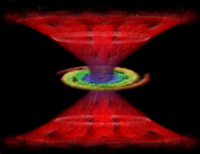Introduction:
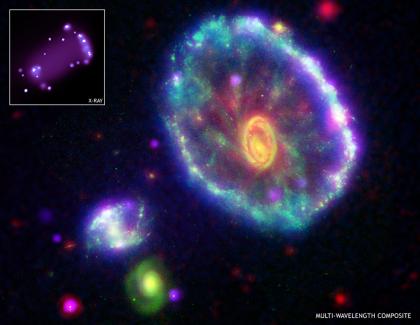
The Cartwheel Galaxy
Multi-Wavelength Composite
The Cartwheel Galaxy is part of a group of galaxies ~five hundred million (500x106) light years away in the direction of the constellation Sculptor. The composite image to the left shows the unique structure of the Cartwheel Galaxy. The image combines data from four different observatories: the Chandra X-ray Observatory (purple); the Galaxy Evolution Explorer satellite (ultraviolet/blue), the Hubble Space Telescope (visible/green), and the Spitzer Space Telescope (infrared/red). The ring-shaped rim of the Cartwheel Galaxy is the result of a rare and spectacular head-on collision between two galaxies. The Cartwheel Galaxy was probably a normal spiral structure galaxy similar to the Milky Way Galaxy before the collision. The spiral structure is beginning to re-emerge, as seen in the faint arms or spokes between the outer ring and the bulls-eye shaped nucleus. The gravitational disruption of a smaller intruder galaxy passing through the Cartwheel Galaxy compressed the interstellar gas and dust – causing a wave of star formation to move out from the impact point like a ripple across the surface of a pond.

The Intruder Galaxy
(NRAO, ISU, Hughes STX, STScI, NASA)
The image to the right is a composite showing an optical image of the Cartwheel galaxy and several smaller galaxies associated with the Cartwheel group superimposed with high resolution radio observations of neutral hydrogen (traced by the green contours). The neutral hydrogen trail suggests that the intruder galaxy could be the galaxy located at the lower left of the image.
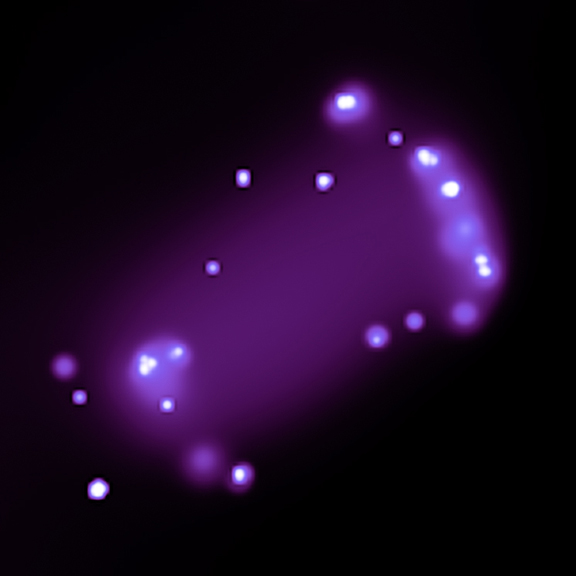
U/HLX’s in Cartwheel Galaxy
(Chandra Image)
The Cartwheel Galaxy provides an opportunity to study how extremely massive stars are formed in large fragmented gas clouds. The ring structure contains several billion new stars that would not normally have been created in such a short time span. When the most massive of these stars undergo catastrophic collapse as supernova events, neutron stars and black holes are formed. Young supernovas and supernova remnants are ultra and hyperluminous X-ray sources (U/HLXs). Some of the neutron stars and black holes are in contact binary systems with companion stars. Material is pulled from the companion stars and forms accretion discs around the neutron stars and back holes due to their extreme gravitational fields. The in-fall of material from the accretion disc produces highly energetic X-rays, so these systems are also classified as U/HLXs.
Investigation:
Purpose: To examine and compare the Cartwheel Galaxy in optical and X-ray bands and determine the sources of the ultra- and hyperluminous x-rays (U/HLXs).
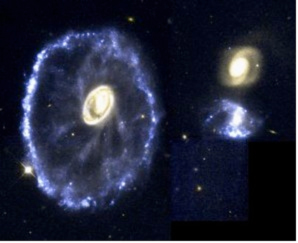
Figure 1. Credit: NASA, ESA, and K. Borne (STScI)
The gravitational disruption of a smaller intruder galaxy passing through the Cartwheel Galaxy compressed the interstellar gas and dust, causing a wave of star formation to move out from the impact point like a ripple across the surface of a pond at ~200,000 mi/hr. The wave of new star formation from the head-on collision has produced the ring-like structure seen in the optical image in Figure 1.
In Figures 2-6, the Chandra X-ray data (on the left) and the Hubble data (on the right) are aligned and displayed side-by-side in ds9 analysis software. The crosshairs are set in different places in each figure to mark various features for reference purposes.
Questions:
1. In Figures 2 and 3, a green circular region has been drawn around the Cartwheel Galaxy in the optical image. The crosshairs are moved on the X-ray image to measure the diameter of the region in pixels (see the x and y physical coordinates in the upper left for the location of the crosshairs). In a Chandra observation, 1 pixel = 0.5 arc sec and 1 radian = 206,265 arc sec. Determine the diameter of the ring in radians.
2. Using the small angle formula and the answer to #1, find the diameter of the ring in light years given a distance to the Cartwheel Galaxy of ~380 million light years.
3. Determine how long ago the collision of galaxies may have occurred using an expansion rate of ~200,000 mi/hr.
The supermassive black hole at the center of an Active Galaxy is called an Active Galactic Nucleus (AGN). Galaxies that contain an AGN emit enormous amounts of radiation (radio, optical, X-rays, gamma rays) and particle jets and are highly variable. X-rays from AGNs are produced when in-falling material from the surrounding disk is heated to temperatures of millions of degrees as it moves toward the supermassive black hole. Some of the in-falling material escapes as a hot wind that is blown away from the disc at speeds as high as a tenth of the speed of light.
4. From the comparison of the X-ray and optical images of the Cartwheel Galaxy, does it seem to have an AGN? Explain and provide evidence.
5. Use the information provided, the analysis, and the chart of stellar life spans below to explain what types of objects each of the X-ray sources might be. There may be different answers depending upon the location of the X-ray source (i.e. along the ring, within the ring, outside the ring).
Star Mass |
Time (years) |
Spectral Type |
Color |
60 |
3 million |
O3 |
bluest |
30 |
11 million |
O7 |
bluest |
10 |
32 million |
B4 |
bluish |
3 |
370 million |
A5 |
blue-white |
1.5 |
3 billion |
F5 |
white |
1 |
10 billion |
G2 (Sun) |
yellow |
0.1 |
1000's billion |
M7 |
red |





Extension: Arp 147
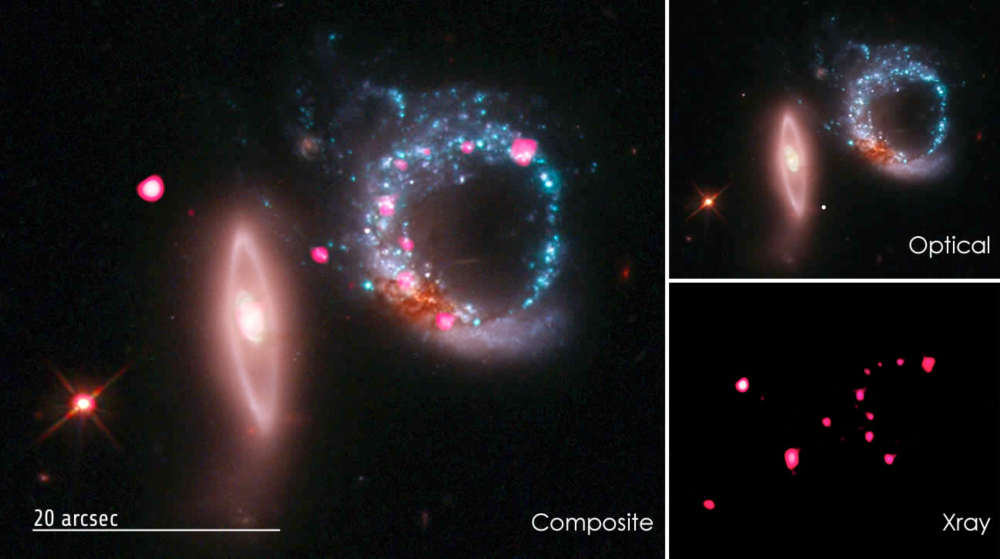
Figure 7. Credit: X-ray: NASA/CXC/MIT/S.Rappaport et al, Optical: NASA/STScI
From observations of objects such as the Cartwheel Galaxy, scientists have seen that a collision between galaxies may trigger a spectacular burst of star formation in galaxies having a high gas content. In July of 2011, Chandra observed the well-known collisional ring galaxy Arp 147. Arp 147 contains the remnant of a spiral galaxy (right) that collided with the elliptical galaxy on the left approximately 150 to 200 million years ago. The optical Hubble image shows a blue ring with a high star formation rate and a pinkish-red region thought to be the nucleus of the original spiral galaxy.
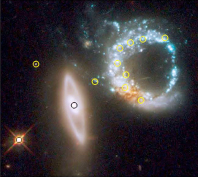
Figure 8. HST image of the Arp 147
with the locations of 12 detected
X-ray sources marked with circles.
6. The recession velocities of the ring galaxy and elliptical galaxy are 9415 km/s and 9656 km/s, respectively. Using a Hubble constant of Ho=72 km/s/Mpc, estimate the distance to Arp 147 in light years. (1 Mpc = 3.26 million ly)
7. Using the scale in Figure 7, estimate the diameter (in light years) of the blue ring of star formation in Arp 147 and compare this to the size of the ring in the Cartwheel Galaxy.
8. Is there an X-ray candidate for an active galactic nucleus (AGN) in Arp 147? Explain.
9. Why might there not be new star formation in the elliptical galaxy on the left?
10. A study of ULXs has determined that very few X-ray sources with luminosity greater than 1040 erg s−1 remain after ~15 Myr and few remain after ~30 Myr.
11. In the Cartwheel galaxy, it appears that a shock wave is moving radially outward in the disk. 9 sources of the 21 detected in the Chandra image of the main ring have a luminosity greater than or equal to 1040 erg s−1. What does this suggest about the time period over which stars have been forming in the Cartwheel?
12. At least seven of the X-ray sources in the ring of Arp 147 qualify as ULXs, but none has a luminosity that exceeds 1040 erg s−1. What does this suggest about the time period over which stars have been forming in Arp 147? How might the geometry of Arp 147 be different than that of the Cartwheel?
References: Compare your findings to those published in the paper, Nonnuclear Hyper/Ultraluminous X-Ray Sources in the Starbursting Cartwheel Ring Galaxy, Yu Gao,1 Q. Daniel Wang,1 P. N. Appleton,2 and Ray A. Lucas3, The Astrophysical Journal Letters, 596:L171–L174, 2003 October 20.
http://www.iop.org/EJ/article/1538-4357/596/2/L171/17541.html


